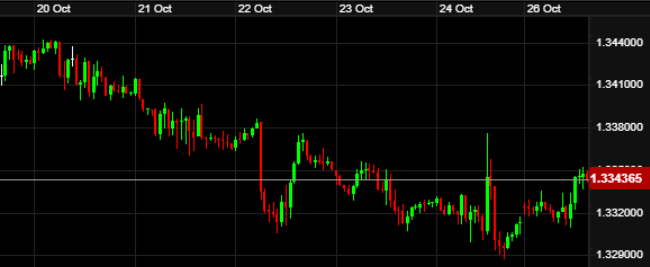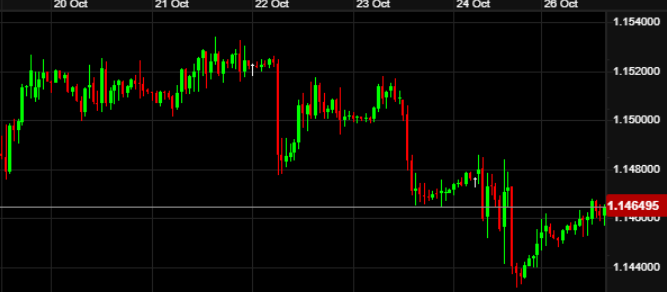ACM Update 27-10-25

As the US government shutdown rumbles on, economic data releases from the States are few and far between. But some employees were called back to compile the September inflation figures, with US CPI running hot at 3.0%, just not quite as hot as markets had feared.
In the UK, inflation held firm for the third month in a row at 3.8%, whilst government borrowing figures continue to make for grim reading.
This week sees interest rate announcements from Canada, the US, Europe and Japan. The Federal Reserve look odds on for another cut, come Wednesday evening whilst the ECB should stay put on Thursday. Other US data releases remain up in the air.
Donald Trump can now officially lay claim to overseeing the two longest government shutdowns in US history. The latest debacle last week passed the 1995/96 effort, to become the second longest. The shutdown during Trump’s first term lasted 35 days, so we have a week or so to go yet to reach that milestone.
At present, circa 1.4 million federal employees are either working without pay or furloughed, with most government services temporarily suspended. Analysts estimate that each week of the shutdown wipes around 0.1/0.2% off US economic growth, roughly $15bn a week.
But some employees were called back from furlough last week, namely at Trump’s favourite Bureau of Labor Statistics, to compile the September inflation report. This was already late by nine days, however was seen as a requirement for assisting the Federal Reserve in making their interest rate announcement this coming week.
The figures showed both good and bad news. Inflation rose to the highest it has been during Trump 2.0 as tariffs continue to feed through to end consumers. Headline CPI hit 3.0% however the reading was under what markets were expecting, leading to a softening of the Dollar late on Friday. With little other data to go off, it suggests the forecast 0.25% Federal Reserve rate cut this Wednesday evening is likely to materialise.
Elsewhere on tariffs, talks between the US & Canada fell apart last week after a fallout over a Canadian advert. The advert cited that Ronald Reagan did not like the idea of tariffs, which led to Trump pulling the plug on talks. He has since, raised tariffs on products from north of the border. The President suggested it might influence the US Supreme Court’s upcoming ruling on the legality of his tariffs, scheduled for 5th November. Fireworks anyone…..
Data releases from non-Federal entities remain the only ones to digest. The latest University of Michigan figures on Consumer Sentiment showed a slight drop, down to their lowest since May. Meanwhile the UoM’s inflation projection from consumers dropped back down.
Fingers crossed the US shutdown starts to see some light at the end of the tunnel soon. But if the 22 hour and 36-minute protest speech about Trump, made by Democratic Senator Jeff Merkley which took place in the Senate last week is anything to go by, progress seems slow.
Movements on Sterling-Dollar last week can be seen in the chart below:

With a quieter picture from the US, drab UK data doesn’t have anywhere to hide at the minute. That was very much the case last week, with GBP losing 1% vs the Dollar and circa 0.5% versus the Euro.
One minor positive was that UK inflation at least didn’t get any worse in September, remaining at the same level of 3.8% that it had been throughout Q3. Food price inflation increased at the slowest rate in more than a year, in fact edging down slightly in the month for the first time since May 2024. Cue the “not satisfied with the numbers” recording from Rachel Reeves.
Major supermarkets though have warned the Chancellor that food price rises will only continue if she imposes higher taxes on the sector in the upcoming Budget. All the UK’s large supermarkets signed the letter to Reeves, in a united warning. Some tax rises are almost inevitable on 26th November, as a result of spending commitments made earlier in the year and rising borrowing costs.
On which note…. The latest government borrowing figures were also published last week. These displayed the biggest September for government borrowing in five years, up by £1.6bn on last year. Borrowing is now at £99.8 billion for the first six months of the financial year, 7% worse than predicted. Estimates suggest £27bn will need to be raised in the Budget.
Other data releases included the September Retail Sales figures. These showed another slight nudge growth for the month of 0.5%. Meanwhile the Services and Manufacturing sectors continued to perform consistently.
With inflation coming in lower than expected, this opens the door to the possibility of another rate cut at the Bank of England’s next meeting, in ten days’ time. The Bank seem committed to their “cautious and gradual” approach though, which may see them stay put for one more meeting.
As always, some members of the committee though are keen for a cut, one of which is Swati Dhingra who spoke last week. She stated that US tariffs are going to put downward pressure on UK inflation in the medium term, whilst calling for another rate cut. She referred to Brexit as an example of the impact of “policy uncertainty” on British trade.
In the lead up to the latest ECB meeting this week, things were relatively quiet on the European front. Christine Lagarde used a speech to declare that the US Dollar is still losing its appeal as a result of trade tariffs. She believes the Euro remains well-placed to be a beneficiary of this as it has been in recent months. There was no specific mention regarding policy for this week’s gathering though.
Her counterpart Joachim Nagel also took aim at the US in referring to the reliability of statistics being vital to monetary policy. Since Trump’s firing of the head of the statistics-producing entity in the US earlier in the summer, many have questioned the credibility of the data emerging from the US.
Nagel also suggested he and the ECB are in no rush to cut rates further. This comes as little surprise to markets, who agree with the ECB that they are currently in a bit of a sweet spot on policy. Inflation remains on or around the 2.0% target, allowing for a focus on growth to take precedent. We expect no change from the ECB come Thursday lunchtime.
For data, Consumer Confidence figures (whilst still low) came in better than forecast on Thursday. These were their “least pessimistic” in 12 months. Services and Manufacturing performance indicators for October were also above expectation, especially for the former. This was backed by the strongest increase for new orders in two and a half years amid expanding Eurozone business activity.
GBP drifted lower against the Euro last week, especially after the inflation releases on Wednesday morning. The chart illustrates this below:

The week ahead:
Monday – German IFO Business Climate (09:00)
Tuesday – UK BRC Shop Price Index (00:01), US Consumer Confidence (Tentative)
Wednesday – Australian CPI Inflation (00:30), UK Mortgage Approvals (09:30), Bank of Canada rate announcement (13:45), Federal Reserve rate announcement (18:00) & Press Conference (18:30)
Thursday – Bank of Japan rate announcement (03:00), ECB rate announcement (13:15) & Press Conference (13:45), US Advance GDP (Tentative)
Friday – ECB CPI Flash Estimate (10:00), US Core PCE Inflation (Tentative)
On to this week and closing out October. A reminder to our clients that UK clocks went back an hour over the weekend to GMT. However, it is another week until the clocks in North America do the same.
With four major central bank meetings to come, there is plenty to digest even in the absence of most US data releases. The two biggest meetings will be that of the Federal Reserve and ECB.
Wednesday evening at 18:00 UK sees the Federal Reserve’s policy decision, expected to deliver a further interest rate cut to 4.00%. This is widely priced in to markets already, along with a further cut of the same amount to come in the December meeting. Narrative in the Jerome Powell press conference (18:30 UK) will be key as to the trajectory of the Dollar ongoing. Even more so given the lack of other releases recently for clues.
For the ECB’s Thursday announcement, we expect little change with a high degree of certainty. As mentioned, inflation is back on track in the bloc. Market movement may come from the Christine Lagarde press conference (13:45 UK) if she signals the committee feel they are now done and dusted with their rate cuts. Although we may still be too soon for that, amidst global uncertainty.
In the UK, little to get excited about in terms of economic data. Mortgage approvals news is unlikely to move GBP massively, whilst it will be a case of awaiting any hints ahead of the upcoming Bank of England meeting next Thursday (6th November).
Despite the absence of US data, there is still plenty of movement as the shutdown itself impacts markets. Uncertainty drives FX markets, and there is plenty of that at the moment from US shores.
For clients with Dollar-related FX exposures, make sure to reach out to the Aston team to understand your options. We are available as always via the usual channels.
Have a great week.